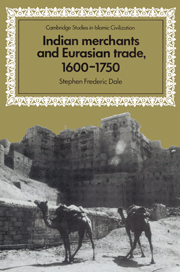Book contents
- Frontmatter
- Contents
- List of illustrations
- Preface
- Note on transliteration
- Abbreviations
- 1 An Indian world economy
- 2 India, Iran and Turan in 1600
- 3 The Indian diaspora in Iran and Turan
- 4 Indo-Russian commerce in the early modern era
- 5 The Indian diaspora in the Volga basin
- 6 Imperial collapse, mercantilism and the Mughul diaspora
- Appendix
- Bibliography
- Index
5 - The Indian diaspora in the Volga basin
Published online by Cambridge University Press: 22 September 2009
- Frontmatter
- Contents
- List of illustrations
- Preface
- Note on transliteration
- Abbreviations
- 1 An Indian world economy
- 2 India, Iran and Turan in 1600
- 3 The Indian diaspora in Iran and Turan
- 4 Indo-Russian commerce in the early modern era
- 5 The Indian diaspora in the Volga basin
- 6 Imperial collapse, mercantilism and the Mughul diaspora
- Appendix
- Bibliography
- Index
Summary
Astrakhan stands at the mouth of the river Volga, on an island formed by two of its branches … in the middle of the town is the principal square, about two hundred yards wide N. and S., and one hundred E. and W. On the east are the houses of the Governor and the Vice-Governor. Opposite is the house occupied by the [Scottish] missionaries. On the south is the Gostenoi Dvor, a range of shops, which, being uniform, have a pleasing and grand appearance … The natives of every country enjoy religious toleration here. The town is full of temples of Hindoos and Kalmucks, of the mosques of the Mahometans, and of the churches of different Christian sects. Astrakhan is considered as the see of the Armenian Archbishop in Russia.
George Keppel: Personal Narrative of a Journey from India to England … in the Year 1824The Indian mercantile settlement of Astrakhan represented a bridgehead of the Indian world economy into the most underdeveloped or “peripheral” European state in the early modern era. Primarily an extension of the substantial Indian commercial presence in Iran, the Indian community came to exercise significant economic influence in the Volga basin by the late seventeenth and early eighteenth century. Using the family firm as the nucleus of their businesses, Indians successfully combined commercial and financial activities to accumulate substantial amounts of capital.
- Type
- Chapter
- Information
- Indian Merchants and Eurasian Trade, 1600–1750 , pp. 101 - 127Publisher: Cambridge University PressPrint publication year: 1994

